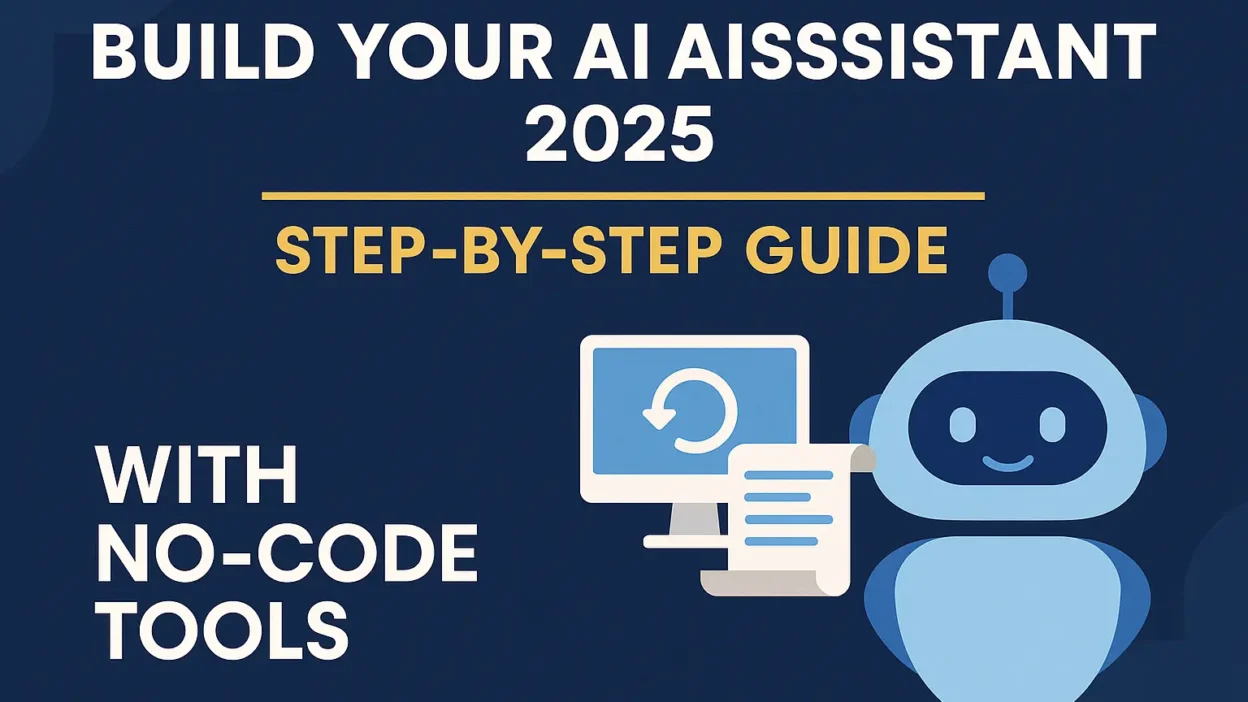Last Updated on July 25, 2025
Build Your Own AI Assistant 2025 using no-code tools, automation platforms, and today’s most advanced AI models. You don’t need to be a developer — anyone can now automate daily tasks, respond to messages, summarize content, and manage schedules using a custom-built AI agent.
In this powerful guide, you’ll learn exactly how to create your own AI assistant step by step — using GPT-4o, Claude, Zapier, Notion, and more.
Tools You’ll Need to Build Your Own AI Assistant 2025
Before starting, make sure you have access to the following tools. Each platform is critical to building, training, and automating your assistant.
| Tool | Use Case |
|---|---|
| ChatGPT Pro | Core logic and natural conversation engine |
| Zapier / Make | Workflow automation and task triggers |
| Notion AI | Workspace memory, summaries, dashboards |
| Voiceflow / Botpress | Chat or voice interface design |
| Airtable / Google Sheets | Store inputs, results, or prompts |
| Webhooks | Real-time action dispatch and integrations |
Why Build Your Own AI Assistant in 2025?
Creating your own AI assistant in 2025 gives you a major productivity edge. With no coding skills required, you can:
- Save 5–10 hours per week on repetitive tasks
- Respond to clients and customers instantly
- Summarize inboxes, meetings, and content automatically
- Build smart workflows across platforms
Whether you’re a solo creator, small business owner, or productivity enthusiast — this guide will help you Build Your Own AI Assistant 2025 in a few hours.
Step 1: Define Your AI Assistant’s Purpose
Start with a narrow focus. Define the primary task your assistant will perform.
Examples:
- Creators: Summarize emails, respond to DMs, manage content calendars
- Businesses: Answer FAQs, process forms, prep reports
- Productivity: Daily task summaries, reminders, meeting briefs
Prompt Template (CRISPE Format):
Context: You are my productivity assistant.
Role: Help manage inbox, calendar, and daily highlights.
Instruction: Summarize all new emails and urgent items.
Structure: Bullet points. Prioritize important items first.
Parameters: Use today’s date. Keep each item under 25 words.
Example: “3 emails. One from John needs reply before 2 PM.”
Use prompt frameworks like CRISPE to control the output, tone, and formatting of your assistant.
Step 2: Choose the Right AI Core
At the heart of your assistant is the LLM (large language model). The most powerful ones in 2025 include:
| AI Model | Strengths |
|---|---|
| GPT-4o | Great for logic, Custom GPTs, fast, voice + image support |
| Claude 3 | Handles long-form documents, strong memory |
| Gemini | Perfect for Gmail, Calendar, and Google Docs integrations |
To Build Your Own AI Assistant 2025 with memory, tone, and reasoning, GPT-4o is the best starting point.
Step 3: Set Up Logic and Automation with Zapier or Make
Once your assistant understands prompts, it must act. Use automation platforms to connect input to output.
Example Workflows:
- New Gmail email → summarize with GPT-4o → add to Notion
- Form submission → generate reply → send via WhatsApp
- Airtable entry → auto-send task list to Slack
Zapier is ideal for fast setup. Make is better for complex, multi-branch automations.
Step 4: Add a Chat or Voice Interface (Optional)
You can let others interact with your assistant using Voiceflow or Botpress. These tools allow:
- Custom chat widgets on your site
- WhatsApp or Telegram AI bots
- Voice-activated assistants for Alexa or Google Assistant
All platforms support memory, fallback responses, and natural language understanding.
Step 5: Train with Prompts, Goals, and Boundaries
To Build Your Own AI Assistant 2025 properly, don’t skip training.
Example Prompt Instruction:
You are Ava, an assistant for content creators. Tasks:
1. Summarize emails
2. Prepare Monday task lists
3. Reply to common DMs
Avoid emojis, personal opinions, or off-topic content.
Include this context in each prompt or as a system message in your GPT setup.
Step 6: Connect to a Workspace Memory System
Let your assistant store data and retrieve it across sessions.
Tools to use:
- Notion AI: Task logs, inbox summaries, CRM notes
- Airtable: Project tracking, deal pipelines, lead follow-ups
- Sheets: Structured input/output summaries
Example: GPT summarizes a client call → stores note in Notion “Meetings” database → auto-tags it with date and client name.
Step 7: Secure and Comply with Privacy Standards
If your assistant touches user data, security is critical.
Checklist:
- Always use secure HTTPS endpoints
- Avoid saving personal/sensitive data unless necessary
- Use disclaimers for public-facing bots
- Let users opt-out of memory tracking
- Follow OpenAI data practices
Step 8: Use Smart Buttons and Commands
Add one-click options and shortcuts for tasks.
Examples:
/summarizein Slack triggers GPT summary- Notion buttons like “Plan Day” or “Summarize Inbox”
- Airtable buttons that send trigger data to OpenAI
This turns your assistant into an actionable tool — not just a conversation bot.
Final Thoughts
If you’re ready to Build Your Own AI Assistant 2025, you’re closer than you think. The tools are available, the integrations are simple, and the benefits are massive.
With GPT-4o, Claude 3, Zapier, Notion AI, and a few well-crafted prompts, you can:
- Automate your entire morning routine
- Answer inquiries in seconds
- Save hours each week
- Operate smarter than 90% of businesses around you
